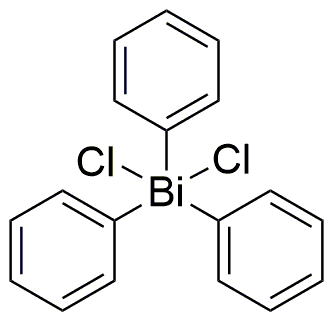Triphenylbismuth dichloride is widely utilized in research focused on:
- Organometallic Chemistry: This compound serves as a precursor in the synthesis of various organometallic compounds, enabling researchers to explore new materials with unique properties.
- Catalysis: It is employed as a catalyst in organic reactions, particularly in the formation of carbon-carbon bonds, which is essential for developing pharmaceuticals and fine chemicals.
- Biological Research: The compound has shown potential in biological applications, including studies on its antitumor activity, making it a candidate for further exploration in cancer treatment.
- Material Science: Used in the development of advanced materials, it contributes to the creation of novel polymers and composites with enhanced thermal and electrical properties.
- Environmental Chemistry: Triphenylbismuth dichloride is investigated for its role in environmental remediation processes, helping to address pollution through chemical transformations.
General Information
Properties
Safety and Regulations
Applications
Triphenylbismuth dichloride is widely utilized in research focused on:
- Organometallic Chemistry: This compound serves as a precursor in the synthesis of various organometallic compounds, enabling researchers to explore new materials with unique properties.
- Catalysis: It is employed as a catalyst in organic reactions, particularly in the formation of carbon-carbon bonds, which is essential for developing pharmaceuticals and fine chemicals.
- Biological Research: The compound has shown potential in biological applications, including studies on its antitumor activity, making it a candidate for further exploration in cancer treatment.
- Material Science: Used in the development of advanced materials, it contributes to the creation of novel polymers and composites with enhanced thermal and electrical properties.
- Environmental Chemistry: Triphenylbismuth dichloride is investigated for its role in environmental remediation processes, helping to address pollution through chemical transformations.
Documents
Safety Data Sheets (SDS)
The SDS provides comprehensive safety information on handling, storage, and disposal of the product.
Product Specification (PS)
The PS provides a comprehensive breakdown of the product’s properties, including chemical composition, physical state, purity, and storage requirements. It also details acceptable quality ranges and the product's intended applications.
Certificates of Analysis (COA)
Search for Certificates of Analysis (COA) by entering the products Lot Number. Lot and Batch Numbers can be found on a product’s label following the words ‘Lot’ or ‘Batch’.
*Catalog Number
*Lot Number
Certificates Of Origin (COO)
This COO confirms the country where the product was manufactured, and also details the materials and components used in it and whether it is derived from natural, synthetic, or other specific sources. This certificate may be required for customs, trade, and regulatory compliance.
*Catalog Number
*Lot Number
Safety Data Sheets (SDS)
The SDS provides comprehensive safety information on handling, storage, and disposal of the product.
DownloadProduct Specification (PS)
The PS provides a comprehensive breakdown of the product’s properties, including chemical composition, physical state, purity, and storage requirements. It also details acceptable quality ranges and the product's intended applications.
DownloadCertificates of Analysis (COA)
Search for Certificates of Analysis (COA) by entering the products Lot Number. Lot and Batch Numbers can be found on a product’s label following the words ‘Lot’ or ‘Batch’.
*Catalog Number
*Lot Number
Certificates Of Origin (COO)
This COO confirms the country where the product was manufactured, and also details the materials and components used in it and whether it is derived from natural, synthetic, or other specific sources. This certificate may be required for customs, trade, and regulatory compliance.


